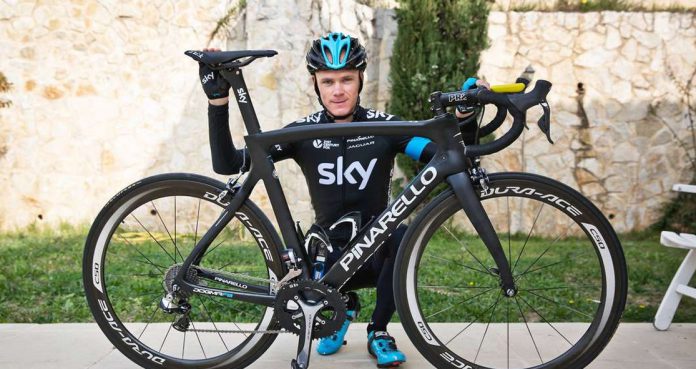Cyclist, Christopher Clive Froome has tried different nutritional practices during his cycling career. He consumes omega-3 fatty acids-rich salmon to repair his muscles, or even gulping 400gm of energy-boosting rice for breakfast. His low-carb training however is found to be the most effective tool.
Monaco resident, Froome tries to avoid cereals or carb-dense bread for breakfast, and performs medium-intensity workout to burn extra fats and increase the energy-producing power of his muscle cells. He is benefitted with enhanced stamina and performance by following the above routine. In fact, this course of action can help any amateur cyclist or runner who wants extensive workout and want to burn more fats.
33-year-old Froome explains, “Low-carb training teaches the body to become more efficient at burning fat as a fuel source, as opposed to just using the readily available glycogen (stored energy) in the muscles. There are two benefits. One is obviously weight-loss, as it is important to keep lean for the mountains. But the main side is the adaptation in the body to use fat as a fuel source and not depend entirely on glycogen.”
Being a part of Team Sky, a professional sports team, Froome’s focus is merely on performance. He explains, “Training this way means I have more fuel available for the last part of races. If your body is burning glycogen for 5-6 hours, you have to be a superhero to still have energy at the end. You can’t take in enough food to replace what you are burning. But if throughout those 5-6 hours your total energy expenditure was 4,000kJ, and by training this way you ensure, say, a quarter of that energy came from burning fat, not glycogen, that is saving a quarter of pure glycogen in the muscles which I can use to attack at the end of the race.”
Professor of Exercise Metabolism at Liverpool John Moores University and Head of Nutrition at Team Sky, James Morton, has helped Froome for discovering his endurance. Morton explains, “The idea of training in carbohydrate-restricted states is to amplify the activation of all the molecular signaling pathways which regulate how our muscles adapt to endurance training. In other words, we are trying to make the muscles have more mitochondria (the powerhouses of the cells which use sugar and fats to make energy); to grow more capillaries to supply those muscles with oxygen; and to increase the body’s ability to use fat as a fuel during moderate-intensity exercise.” And the output is a higher level of workout-stamina.
Other athletes can follow Froome’s methods, manage to burn more fat, and obtain better stamina. Morton states further, “One of the main adaptations that comes with having more mitochondria in your muscles is that you use more fat for a given (exercise) intensity. That is good for endurance because fat is a good fuel source, but it also means when you need to go quicker later on, you should have more carbohydrates left. All of these adaptations happen with standard endurance training anyway, but with carbohydrate-restricted training you get more bang for your buck.”
Morton insists that superior stamina is the primary focus of his training, but it helps to burn fat. “Weight loss is more about the simple equation of calories in, calories out,” Morton said. “Having said that, training low can provide a framework to help you lose weight because if you go for a 5-6 hour ride you have 5-6 hours when you are in a calorie deficit, so you will be burning fat and losing weight over time.”
There are chances of key hormonal changes taking place. “You tend to have a higher adrenaline response when you are in a carbohydrate-restricted state. Adrenaline is one of the hormones that regulates fat metabolism, so in a calorie-restricted training ride you will burn more fat.”
If anyone is experimenting with carbohydrate-restricted training, starting with eating the right meals, carb-restricted training is not the same as fasted training, in which athletes need to omit all food before exercise. Froome skips starchy carbohydrates before a training session, and takes protein and vegetables. The young cyclist says, “In order for this to work, you have to deplete your glycogen stores first and not have a lot of carbs in your body. So my dinner the night before might be chicken or fish and a few vegetable sources, but not rice, pasta or potatoes. For breakfast I might have an omelet or a yoghurt without any honey.”
By including protein in the diet, the muscle power is not taken from the body. Morton explains, “Eventually you could start to lose muscle if this type of training was performed for a long time, but consuming protein protects that muscle.” At the time of training ride, Froome tops up with ‘Science in Sport’ (SiS) protein gels. Recreational riders can consume protein balls or nut bars for boosting strength.
Right training is also the important part of the desired fat burning. A two to six hours low intensity training which could be focusing on long but slow endurance is a golden key. Froome said, “We do long endurance rides several times a week so those are perfect opportunities for this. You are not trying to achieve personal bests or do big intensity sessions. You just go out for a few hours, turning over at a low intensity, so you don’t need a massive fuel source and your body can burn a lot of fat.”
Morton suggests that when going for low-carb training, you should never exceed your threshold while exercising. He adds, “When you do higher intensity efforts around or above your threshold, you need to fuel those rides accordingly with carbohydrates.”
Precisely, Froome follows this carb-restricted training once a week over summer and twice a week over winter. However, without high-carb days, it would be difficult for him to complete the high-intensity intervals. Morton adds, “Some days riders will have high-carbohydrate food to promote training intensity, and some days reduced carbohydrate to promote these endurance adaptations. The way we decide this is simply according to the fuel for the work required.”
People who are going for Carb-restricted training may find it challenging initially. Froome admits by saying, “It doesn’t feel good when you are low. You tend to be more grumpy than normal. But you know as soon as you eat you will feel better. But you can’t do a full six-hour ride low-carb. You will reach a point where you do need to top up with a banana or something.” Froome admits that following a structured diet is sometimes difficult, but even best athletes are occasionally happy to bend the nutritional rules. Froome confesses by saying, “Every once in a while, I will go out and have a big meal, or I will have a roast dinner or a steak and chips. It’s rare – perhaps once or twice a month – but it’s good for the head.”























